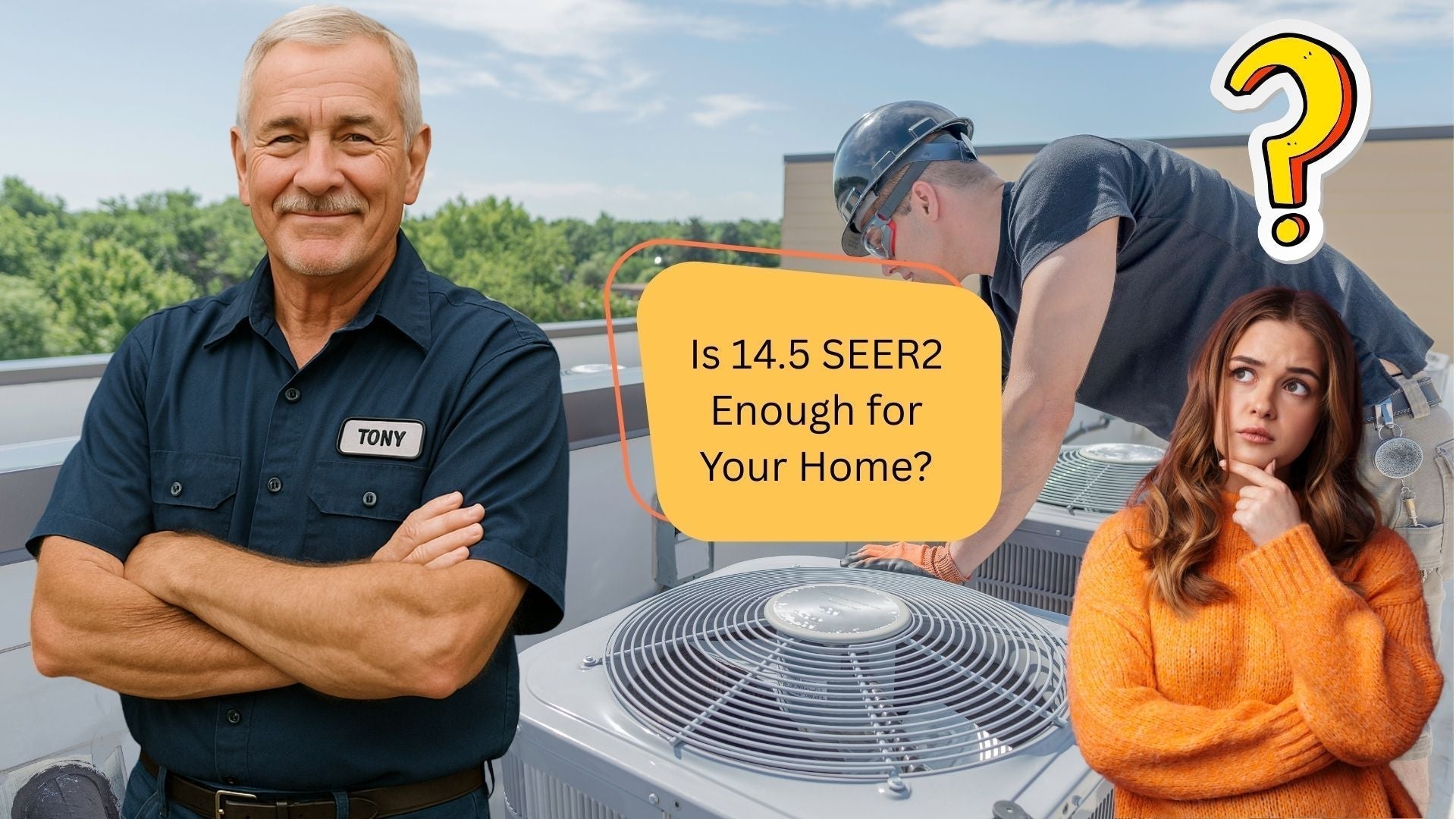(By Tony the Trusted Tech)
You’ve probably heard folks talk about SEER ratings like they’re some magic number. But let me tell you straight—SEER2 is just one piece of the HVAC puzzle. And 14.5 SEER2? It’s not fancy, but it’s reliable, affordable, and efficient enough for 90% of the homes I walk into.
So if you’re staring at a 20-year-old AC unit on its last legs, or your contractor just quoted you on a 14.5 SEER2 system like this Goodman 3 Ton R-32 setup, here’s everything you need to know to make the call with confidence.
For a real-world example of a balanced SEER2 system that works, check out this 3 Ton Goodman R-32 model.
What the Heck is SEER2, Anyway?
Let’s back it up a minute. SEER stands for Seasonal Energy Efficiency Ratio. It’s basically how much cooling your system puts out versus how much juice it uses over a typical season.
But in 2023, the feds updated how that number gets tested—enter SEER2, which is a bit more real-world. It accounts for more resistance in the ductwork and simulates actual field conditions.
So when you hear “14.5 SEER2,” think of it like the new equivalent to around 15.5–16 SEER under the old system.
✅ Bottom Line: SEER2 is a better reflection of what you’re actually gonna pay to run your AC.
Is 14.5 SEER2 Efficient Enough in 2025?
Short answer? Yes—for most homes.
Long answer? It depends on:
-
Your climate – Live in Phoenix? You’ll want higher. But in Ohio? 14.5 works just fine.
-
Your energy rates – If power costs are sky-high, go more efficient if your budget allows.
-
Your usage – If you only run AC part of the year, you won’t recoup the cost of a pricier 18+ SEER system.
For a standard 1,500–2,500 sq. ft. home, 14.5 SEER2 hits that sweet spot of comfort and cost. You’ll save over your old unit, but you won’t break the bank up front.
Want proof? According to the U.S. Department of Energy, even moving from a 10 SEER unit to a 14.5 SEER2 can cut your cooling costs by 30% or more.
The Real Savings Over Time
Let’s say you’ve got a dinosaur—like a 10 SEER unit from 2004. If your annual cooling costs are $1,200, upgrading to 14.5 SEER2 could drop that to around $850/year.
That’s $350 back in your pocket every year.
Over 10 years? That’s $3,500 in savings—and your new system might only cost that much to begin with.
💬 “I’ve seen folks spend double for 20 SEER systems and never make their money back. Don’t overbuy unless you need to.” —Tony
Why Goodman’s 14.5 SEER2 R-32 System Is a No-Brainer
Here’s where I stop talking theory and point you to a setup I actually like: the Goodman 3 Ton 14.5 SEER2 system with R-32 refrigerant. You can check it out here.
Why It Works:
-
R-32 refrigerant – Lower Global Warming Potential than R-410A, and it’s got better heat transfer. That means more cooling, less energy. Daikin even made the switch years ago.
-
Solid Goodman components – These units are built for techs like me. Serviceable, tough, and stocked with parts at most local supply houses.
-
14.5 SEER2 sweet spot – Right where performance and price meet.
I’ve installed this setup—or ones just like it—dozens of times for landlords and middle-income families, and it just works.
Should You Go Higher Than 14.5 SEER2?
Here’s when I’d recommend spending extra for a higher SEER2 system:
-
You live in the Deep South or Southwest and run AC 10 months a year.
-
You’re building a net-zero or ultra-efficient home.
-
You’ve got state rebates that make the upgrade basically free (check with DSIRE).
Otherwise? Don’t let the marketing fool you. A higher SEER2 number doesn’t always mean it’ll last longer or cool better. And if the upfront cost eats into your budget for ductwork, insulation, or smart thermostats? You’re better off going with a balanced 14.5 SEER2 system and upgrading the rest.
Maintenance Still Matters—No Matter the SEER2
Even the best-rated unit will choke if you don’t take care of it.
Pro Tips from the Field:
-
Change your filters every 1–3 months. No exceptions.
-
Clean your outdoor coil every spring.
-
Don’t block return vents with furniture or rugs.
-
Get a tune-up once a year before the season starts.
Want a full breakdown? I’ve got a complete HVAC maintenance checklist for homeowners from the Energy Department.
Final Verdict: 14.5 SEER2 is Enough for Most Homes
If you're a homeowner, property manager, or DIY-savvy buyer looking for dependable cooling that won’t bust your monthly utility bill, a 14.5 SEER2 system is a smart, safe bet.
Especially when you go with something like this Goodman R-32 3 Ton setup. It’s simple, tough, and built with the next 10–15 years of regulations and refrigerant shifts in mind.
Tony’s Bottom Line
“If you want bragging rights, go buy a 22 SEER inverter. If you want a system that cools your house and doesn’t eat your wallet, 14.5 SEER2 is the one to beat.”
Stick with what works, install it right, and keep it clean. That’s how you win with HVAC.







